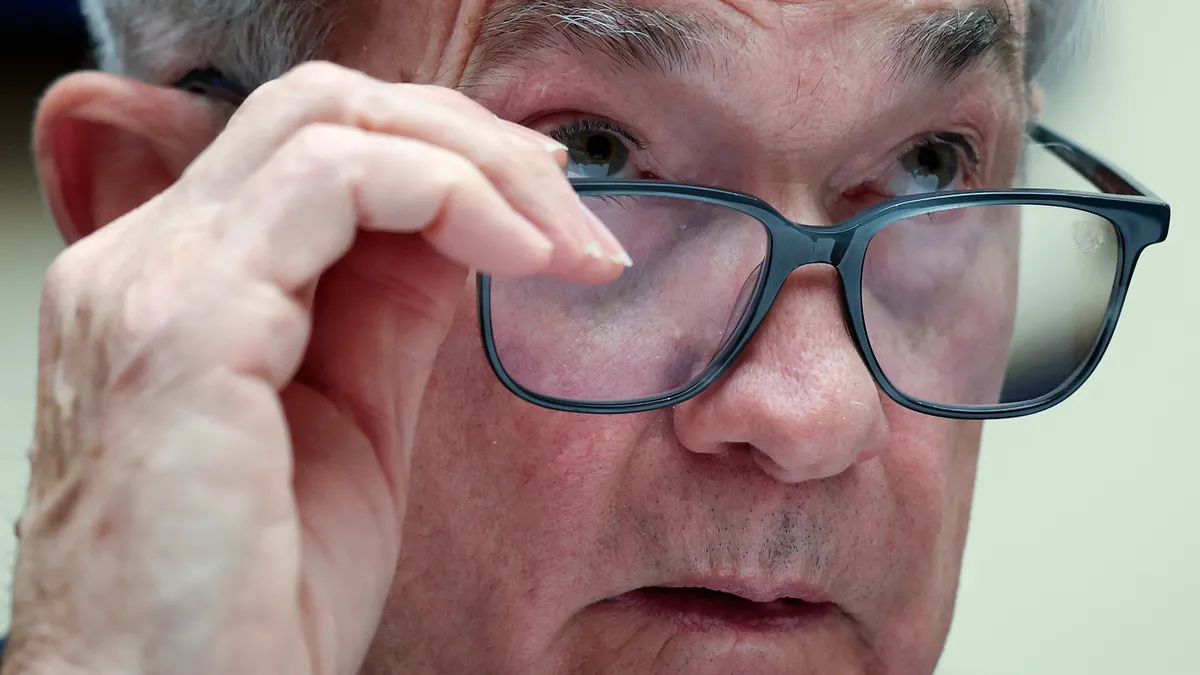Dive Brief:
- Federal Reserve Chair Jerome Powell said Wednesday that policymakers will likely tighten monetary policy again this year after pausing to assess whether their 10 straight rate hikes since early last year are enough to ease price pressures.
- “We remain committed to bringing inflation back down to our 2% goal,” Powell said in testimony to the House Financial Services Committee. “Nearly all FOMC [Federal Open Market Committee] participants expect that it will be appropriate to raise interest rates somewhat further by the end of the year.”
- Inflation has persisted at more than twice the central bank’s target partly because demand for labor has far exceeded supply for many months, Powell said. “Inflation pressures continue to run high and the process of getting inflation back down to 2% has a long way to go.”
Dive Insight:
The central bank suspended rate hikes on June 14 even as FOMC participants raised their median projection for the federal funds rate at the end of the year to 5.6% from 5.1% in March.
Fed officials, in another median estimate, forecast that their preferred measure for inflation — the core personal consumption expenditures price index — will end the year at 3.9%, an increase of 0.3 percentage points from their forecast in March.
In assessing whether to further raise the main interest rate, “we will take into account the cumulative tightening of monetary policy, the lags with which monetary policy affects economic activity and inflation and economic and financial developments,” Powell said.
Responding to a lawmaker’s question about the pause in tightening, he said, “the level to which we raise rates is actually a separate question from the speed with which we moved earlier in the process.”
“Given how far we’ve come, it may make sense to move rates higher but to do so at a more moderate pace,” he said. “We’re monitoring that pace much as you would do if you were driving 75 miles [an hour] on the highway, then 50 miles an hour on a local highway” before slowing more upon arrival.
Recent data underscore that the Fed’s most aggressive fight against inflation in four decades has so far yielded mixed results.
The consumer price index slowed in May to a 4% annual rate compared with 4.9% in April, the Labor Department said last week. The core CPI, which excluded volatile food and energy prices, eased to 5.3% during the same period compared with 5.5% in April.
Yet high inflation persists because policymakers have failed to cool the red-hot labor market and curb wage growth.
A springtime surge in job gains persisted last month as employers hired 339,000 workers and wage growth — while slowing from a 4.9% annual rate a year ago — rose 0.3% during the month and a still-strong 4.3% during the past 12 months.
“The labor market remains very tight,” Powell said Wednesday, noting that during the first five months of 2023 job gains averaged 314,000 per month. Also, unemployment rose 0.3 percentage points in May but remained unusually low at 3.7%.
Two other policymakers Wednesday pledged to slow inflation in testimony to the Senate Banking Committee.
“Inflation has started to abate, and I remain focused on returning it to our 2% target,” Fed Governor Philip Jefferson said. He is seeking Senate confirmation to serve as Fed Vice Chair.
Fed Governor Lisa Cook echoed Jefferson.
“The American economy is at a critical juncture, and it will be essential for the FOMC to act as needed to bring inflation back to our 2% inflation target,” she told the Senate committee. She has been nominated to a new 14-year term at the central bank.
The full impact of the Fed’s tightening may not appear for some time, Powell said, noting that price pressures have remained high for much longer than anticipated.
“Inflation has consistently surprised us and essentially all other forecasters by being more persistent than expected,” Powell said. “I do believe that the process of bringing inflation down is going to be a relatively lengthy one, longer than we expected.”
Powell, in response to a lawmaker’s question, declined to predict the level of the federal funds rate that will enable the Fed to fulfill its dual mandate of price stability and maximum employment.
“I think it’s really hard to know,” he said. “It’s a great question.”












